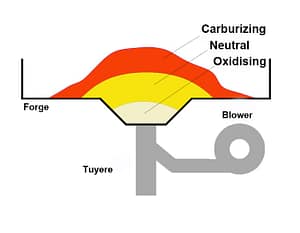LEARNING THE FORGE FIRE
Welcome to the basics of blacksmithing.
One of the first things to learn about forging is building, controlling and managing your forge fire. A properly managed fire will offer you a more productive session and use less fuel than a fire that is left to run wild.
Forge design has a great bearing on how efficient your fire will perform. A forge designed to the correct proportions, will allow a fire to be maintained at the right height and have distinctive zones of heat. The three zones are oxidizing, neutral and carburizing heats.
FIRE ZONES AND THEIR USAGE
The top layer or Carburizing zone is used for preheating the steel prior to placing into the neutral zone, if required. A forging heat can not be obtained in this zone. This zone also maintains the neutral zone heat by forming an insulating layer on top of the fire.
The middle layer is the Neutral zone and is the part of the fire that is used to bring steel to forging temperature and fire welding heat.
The bottom layer is the Oxidising or Reducing zone. Steel must not be placed in this zone, as it will cause burning and scaling of the work. This zone contains the impurities of the combustion process as the life of the fire proceeds.
The first couple of hours of the fires life will see impurities form at the base of the fire. This is generally referred to as Clinker. Clinker should be removed from the fire on a regular basis. To remove clinker from the fire, the air supply should be cut off and the fire allowed to cool down. This will allow the clinker to form a solid mass that can be removed with fire tools and disposed of.
Do not attempt to remove clinker from a forging fire at running temperature. The clinker will be too friable and break into small pieces that make removal harder to perform. If the fire should fail to breathe, you can gently ‘lift’ the fire with a fire tool to allow air to circulate through the fuel. In order to maintain an efficient fire heat, it is important to keep the top of the fire black, by placing fresh coke on top of the fire. If the fire is glowing bright orange, it is wasting fuel and radiating bright light and heat into your face. On a day of high temperatures, it tends to be uncomfortable.
Coming up next:- Blacksmith Tools.
